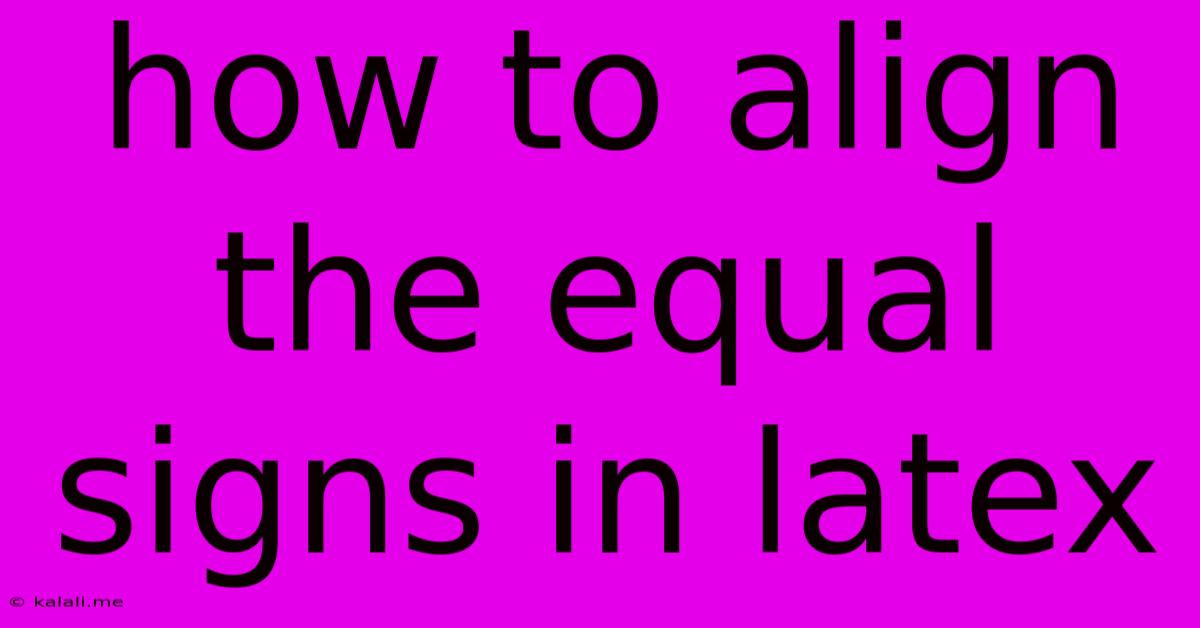How To Align The Equal Signs In Latex
Kalali
May 24, 2025 · 3 min read

Table of Contents
How to Align Equal Signs in LaTeX: A Comprehensive Guide
This guide provides a comprehensive overview of aligning equal signs in LaTeX, a crucial aspect of typesetting mathematical equations and formulas clearly and professionally. Proper alignment enhances readability and improves the overall aesthetic appeal of your documents. We'll cover various methods, from simple to complex scenarios, ensuring you can effectively align equations regardless of their complexity.
Understanding the Problem: Why Align Equal Signs?
When writing multiple equations, especially those spanning several lines, misaligned equal signs can make the text difficult to read and understand. This is especially true in mathematical proofs or derivations where the sequential steps need to be visually clear. Consistent alignment improves the visual flow, making it easier to follow the logical progression of your work.
Basic Alignment with align Environment
The simplest and most common way to align equal signs is using the align environment from the amsmath package. This environment provides automatic alignment at the specified character, typically the equal sign.
\begin{align}
y &= mx + c \\
x &= \frac{y - c}{m} \\
m &= \frac{y - c}{x}
\end{align}
This code will produce three equations, each with the equal sign perfectly aligned vertically. Remember to include \usepackage{amsmath} in your document's preamble.
More Control with aligned Environment
The aligned environment offers similar functionality but is designed for inclusion within other environments, such as equation. This is beneficial for aligning equations within a larger, numbered equation.
\begin{equation}
\begin{aligned}
y &= mx + c \\
x &= \frac{y - c}{m}
\end{aligned}
\end{equation}
This will create a single, numbered equation with the two inner equations aligned.
Handling Multiple Alignment Points with alignat
For equations requiring alignment at multiple points, use the alignat environment. The first argument specifies the number of alignment points.
\begin{alignat}{2}
x + y &= 5 &\quad x - y &= 1 \\
2x &= 6 &\quad 2y &= 4 \\
x &= 3 &\quad y &= 2
\end{alignat}
This example demonstrates aligning at two points (the & symbol indicates alignment points). Note the use of \quad to add spacing between aligned columns.
Fine-Tuning Alignment with cases Environment
When dealing with piecewise functions or similar structures, the cases environment is very useful.
f(x) = \begin{cases}
x^2 & \text{if } x > 0 \\
0 & \text{if } x = 0 \\
-x^2 & \text{if } x < 0
\end{cases}
While not directly aligning equal signs, the cases environment provides a structured way to present equations with different conditions, improving overall readability.
Advanced Techniques: Manual Alignment with \hspace and \phantom
For more complex scenarios or fine-grained control, use \hspace to insert horizontal space and \phantom to create invisible space matching the width of a specific element. This allows manual alignment when automatic alignment doesn't suffice. However, this requires more manual effort and is generally less efficient than the built-in environments.
Conclusion: Choosing the Right Method
Selecting the best alignment method depends on the specific needs of your equation. For simple alignments, the align environment is sufficient. For more complex situations or nested equations, aligned or alignat offer greater flexibility. Remember to always use the amsmath package for optimal results and consistent output. By mastering these techniques, you can ensure your LaTeX documents present mathematical equations with clarity, precision, and professional aesthetics.
Latest Posts
Latest Posts
-
How To Get Rid Of Oil Stains On Driveway
May 24, 2025
-
How To Remove Tub Drain Plug
May 24, 2025
-
Can A Muslim Marry A Christian
May 24, 2025
-
Why Wont My Ps4 Controller Connect
May 24, 2025
-
Why Does My Smoke Alarm Keep Beeping
May 24, 2025
Related Post
Thank you for visiting our website which covers about How To Align The Equal Signs In Latex . We hope the information provided has been useful to you. Feel free to contact us if you have any questions or need further assistance. See you next time and don't miss to bookmark.